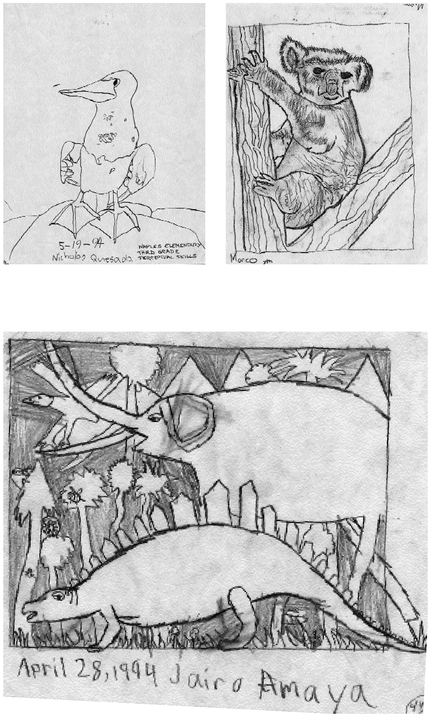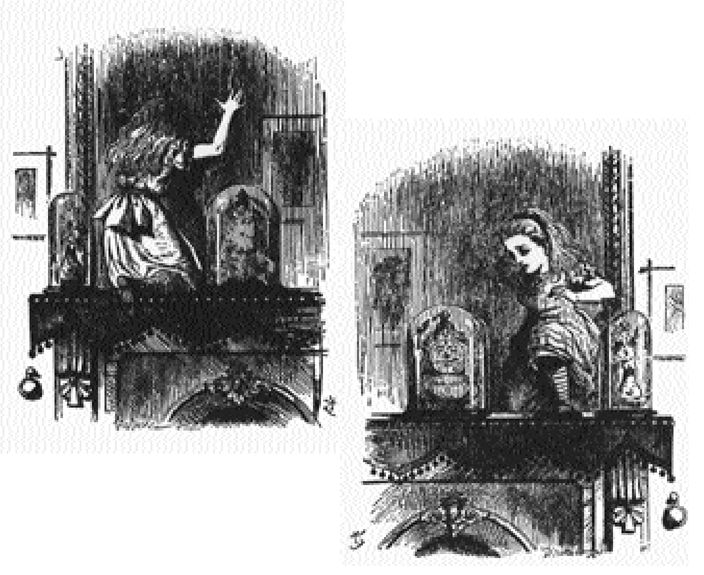The New Drawing on the Right Side of the Brain (19 page)
Read The New Drawing on the Right Side of the Brain Online
Authors: Betty Edwards

BOOK: The New Drawing on the Right Side of the Brain
7.64Mb size Format: txt, pdf, ePub
Fig. 5-17. Children’s unsuccessful attempts to draw a cube that “looks real.”

Fig. 5-18. Realistic depiction of a cube requires drawing uncubelike shapes.
“The painter who strives to represent reality must transcend his own perception. He must ignore or override the very mechanisms in his mind that create objects out of images. . . . The artist, like the eye, must provide true images and the clues of distance to tell his magic lies.”
—Colin Blakemore
Mechanics of the Mind,
1977
Mechanics of the Mind,
1977
From childhood onward, we have learned to see things in terms of words: We name things, and we know facts about them. The dominant left verbal system doesn’t want too much information about things it perceives—just enough to recognize and to categorize. It seems that one of its functions is to screen out a large proportion of contextual perceptions. This is a necessary process and one that works very well for us most of the time, enabling us to focus our attention. The left brain, in this sense, learns to take a quick look and says, “Right, that’s a chair (or an umbrella, bird, tree, dog, etc.).” But drawing requires that you look at something for a long time, perceiving lots of details and how they fit together, registering as much information as possible—ideally, everything, as Albrecht Dürer apparently tried to do in Figure 5-19.
If verbal knowledge of the cube’s real shape overwhelms the student’s purely visual perception, “incorrect” drawing results—drawing with the kinds of problems that make adolescents despair (see Figure 5-17). Knowing that cubes have square corners, students usually start a drawing of a cube with a square corner. Knowing that a cube rests on a flat surface, students draw straight lines across the bottom. Their errors compound themselves as the drawing proceeds, and the students become more and more confused.
Though a sophisticated viewer, familiar with the art of cubism and abstraction, might find the “incorrect” drawings in Figure 5-17 more interesting than the “correct” drawings in Figure 5-18, young students find praise of their wrong forms incomprehensible. In this case, the child’s intent was to make the cube look “real.” Therefore, to the child, the drawing is a failure. To say otherwise seems as absurd to students as telling them that “two plus two equals five” is a creative and praiseworthy solution.
On the basis of “incorrect” drawings such as the cube drawings, students may decide that they “can’t draw.” But they can draw; that is, the forms indicate that manually they are perfectly able to draw. The dilemma is that previously stored knowledge—which is useful in other contexts—prevents their seeing the thing-as-it-is, right there in front of their eyes.
Sometimes the teacher solves the problem by showing the students how—that is, by demonstrating the process of drawing. Learning by demonstration is a time-honored method of teaching art, and it works if the teacher can draw well and has confidence enough to demonstrate realistic drawing in front of a class. Unfortunately, most teachers at the crucial elementary level are themselves not trained in perceptual skills in drawing. Therefore, teachers often have the same feelings of inadequacy concerning their own ability to draw realistically as the children they wish to teach.
Many teachers wish children at this age would be freer, less concerned about realism in their artwork. But however much some teachers may deplore their students’ insistence on realism, the children themselves are relentless. They will have realism, or they will give up art forever. They want their drawings to match what they see, and they want to know how to do that.
I believe that children at this age love realism because they are trying to learn how to see. They are willing to put great energy and effort into the task if the results are encouraging. A few children are lucky enough to accidentally discover the secret: how to see things in a different (R-mode) way. I think I was one of those children who, by chance, stumbles on the process. But the majority of children need to be taught how to make that cognitive shift. Fortunately, we are now developing new instructional methods, based on recent brain research, which will enable teachers to help satisfy children’s yearning for seeing and drawing skills.
How the symbol system, developed in childhood, influences seeingNow we are coming closer to the problem and its solution. First, what prevents a person from seeing things clearly enough to draw them?
The left hemisphere has no patience with this detailed perception and says, in effect, “It’s a chair, I tell you. That’s enough to know. In fact, don’t bother to look at it, because I’ve got a ready-made symbol for you. Here it is; add a few details if you want, but don’t bother me with this looking business.”
And where do the symbols come from? From the years of childhood drawing during which every person develops a system of symbols. The symbol system becomes embedded in the memory, and the symbols are ready to be called out, just as you called them out to draw your childhood landscape.
The symbols are also ready to be called out when you draw a face, for example. The efficient left brain says, “Oh yes, eyes. Here’s a symbol for eyes, the one you’ve always used. And a nose? Yes, here’s the way to do it.” Mouth? Hair? Eyelashes? There’s a symbol for each. There are also symbols for chairs, tables, and hands.
To sum up, adult students beginning in art generally do not really see what is in front of their eyes—that is, they do not perceive in the special way required for drawing. They take note of what’s there, and quickly translate the perception into words and symbols mainly based on the symbol system developed throughout childhood and on what they know about the perceived object.
“By the time the child can draw more than a scribble, by age three or four years, an already well-formed body of conceptual knowledge formulated in language dominates his memory and controls his graphic work. . . . Drawings are graphic accounts of essentially verbal processes. As an essentially verbal education gains control, the child abandons his graphic efforts and relies almost entirely on words. Language has first spoilt drawing and then swallowed it up completely.”
—Written in 1930 by
psychologist Karl Buhler
psychologist Karl Buhler
“I must begin, not with hypothesis, but with specific instances, no matter how minute.”
—Paul Klee
What is the solution to this dilemma? Psychologist Robert Ornstein suggests that in order to draw, the artist must “mirror” things or perceive them exactly as they are. Thus, you must set aside your usual verbal categorizing and turn your full visual attention to what you are perceiving—to all of its details and how each detail fits into the whole configuration. In short, you must see the way an artist sees.
Fig. 5-19. Albrecht Dürer, Study for the
Saint Jerome
(1521).One of the L-mode functions is to screen out a large proportion of incoming perceptions. This is a necessary process to enable us to focus our thinking and one that works very well for us most of the time. But
drawing
requires that you look at something for a long time, perceiving lots of details, registering as much information as possible—ideally,
everything,
as Albrecht Dürer tried to do here.
Saint Jerome
(1521).One of the L-mode functions is to screen out a large proportion of incoming perceptions. This is a necessary process to enable us to focus our thinking and one that works very well for us most of the time. But
drawing
requires that you look at something for a long time, perceiving lots of details, registering as much information as possible—ideally,
everything,
as Albrecht Dürer tried to do here.


Given proper instruction, young children can easliy learn to draw. These examples are by third-grade children, age eight.
“Art is a form of supremely delicate awareness . . . meaning at-oneness, the state of being at one with the object. . . . The picture must all come out of the artist’s inside. . . . It is the image that lives in the consciousness, alive like a vision, but unknown.”
—D. H. Lawrence, the
English writer, speaking
about his paintings
English writer, speaking
about his paintings
Again, the key question is how to accomplish that cognitive L→R shift. As I said in Chapter Four, the most efficient way seems to be to present the brain with a task the left brain either can’t or won’t handle. You have already experienced a few of those tasks: the Vase/Faces drawings and the upside-down drawing. And to some extent, you have already begun to experience and recognize the alternate state of right-hemisphere mode. You are beginning to know that while you are in that slightly different subjective state of mind, you slow down so that you can see more clearly.
As you think back over experiences with drawing since you started this book and over experiences of alternative states of consciousness you may have had in connection with other activities (freeway driving, reading, etc., mentioned in Chapter One), think again about the characteristics of that slightly altered state. It is important that you continue to develop your awareness and recognition of R-mode state.
Lewis Carroll described an analogous shift in Alice’s adventures in
Through the Looking Glass:
Through the Looking Glass:
“Oh, Kitty, how nice it would be if we could only get through into Looking Glass House! I’m sure it’s got, oh! such beautiful things in it! Let’s pretend there’s a way of getting through into it, somehow, Kitty. Let’s pretend the glass has got all soft like gauze, so that we can get through. Why, it’s turning to a mist now, I declare! It’ll be easy enough to get through....”

Let’s review the characteristics of the R-mode one more time. First, there is a seeming suspension of time. You are not aware of time in the sense of marking time. Second, you pay no attention to spoken words. You may hear the sounds of speech, but you do not decode the sounds into meaningful words. If someone speaks to you, it seems as though it would take a great effort to cross back, think again in words, and answer. Furthermore, whatever you are doing seems immensely interesting. You are attentive and concentrated and feel “at one” with the thing you are concentrating on. You feel energized but calm, active without anxiety. You feel self-confident and capable of doing the task at hand. Your thinking is not in words but in images and, particularly while drawing, your thinking is “locked on” to the object you are perceiving. On leaving R-mode state, you do not feel tired, but refreshed.
Other books
A Matter of Trust by Lorhainne Eckhart
A Choice of Treasons by J. L. Doty
Late in the Day by Le Guin, Ursula K.
The Breach by Lee, Patrick
High Country : A Novel by Wyman, Willard
Trumpet on the Land by Terry C. Johnston
The Songs of the Kings by Barry Unsworth
The Shelter of His Arms (Harlequin Heartwarming) by Dawn Stewardson
Can You Keep a Secret? by Caroline Overington
Tales of the South Pacific by James A. Michener